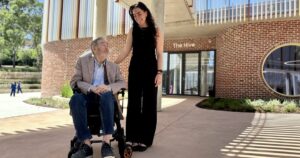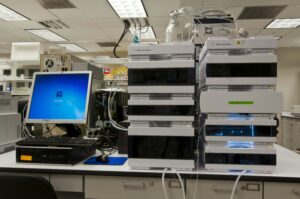
Alec Whited, a 2025 Master’s graduate in Biology from the University of Texas at Arlington (UTA), has made a significant discovery that could revolutionize treatments for autoimmune diseases and enhance wound healing processes. While conducting research in the Ghose Lab at UTA, Whited identified a novel cellular pathway that plays a crucial role in the removal of dying cells, a discovery that was recently published in the prestigious journal Genetics.
“Similar to taking your garbage out on trash day, living things must also get rid of their unwanted waste, whether it’s digested food or dead cells that have fulfilled their purpose,” explained Whited, who is now a research assistant at UT Southwestern. “This work helps us understand a specific step in the process of clearing those cells that have completed their job and are no longer needed. When this process is interrupted or does not work, it can cause major issues for the organism.”
Implications for Autoimmune Diseases and Inflammation
The discovery of this cellular pathway is particularly significant in the context of autoimmune diseases. According to Whited, the improper clearance of dead cells can lead to inflammation, a common factor in many autoimmune disorders. “Inflammation can be caused by many factors, and one of them is the failure to clear dead cells properly,” Whited noted. “When cells die, they release molecules that can trigger inflammatory responses. If these dead cells aren’t cleared out efficiently, the body may mistakenly interpret these molecules as threats and launch an immune response. This can lead to chronic inflammation and contribute to autoimmune diseases.”
Potential Advancements in Wound Healing
Whited’s research also holds promise for improving wound healing. One of the genes studied has been linked to cell-to-cell fusion, a critical process in repairing tissues and closing wounds. “By better understanding the genetic mechanisms behind this, we hope to identify additional genes that could play a role in improving wound healing,” Whited said. “This could have implications in advancing our knowledge of how we can accelerate wound healing or treat chronic wounds, though much more research is needed to fully understand how.”
Aspiring Scientists and the UTA Research Environment
Reflecting on his journey and the environment at UTA, Whited shared valuable insights for aspiring scientists. “While I can’t speak for every department at UTA, I can say that the Department of Biology has been incredibly supportive,” he remarked. “The faculty and students share genuine excitement for research. There’s a collaborative spirit that drives everyone to push the boundaries of what we know.”
Whited emphasized the importance of a supportive research environment in fostering academic and personal growth. “This mindset fosters not only academic growth, but also a sense of belonging in the broader scientific community. Ultimately, I believe this is the core goal of science: to make meaningful contributions that help us understand the world around us and leave a lasting impact on the field. UTA cultivates that environment, and it’s been an exciting place to develop as both a researcher and a future scientist.”
Support and Recognition
Whited’s research was supported by The Cancer Prevention Research Institute of Texas (RR100091) and the National Institutes of Health–National Institute of General Medical Sciences (R35GM142489). The publication of his findings in Genetics marks a significant milestone in his early research career. “It’s a tremendous honor,” Whited said. “Even before my research career truly began, I had heard of this prestigious journal, and to now be part of it feels surreal. It’s a recognition not just of my individual work, but of the incredible support I’ve received from mentors and colleagues.”
The University of Texas at Arlington, celebrating its 130th anniversary in 2025, continues to be a hub of innovation and research excellence. As a Carnegie R-1 university, UTA stands among the nation’s top 5% of institutions for research activity, making significant contributions to both the academic and local communities.
Whited’s groundbreaking study not only highlights the potential for new treatments and therapies but also underscores the vital role of academic institutions like UTA in advancing scientific knowledge and fostering the next generation of researchers.







